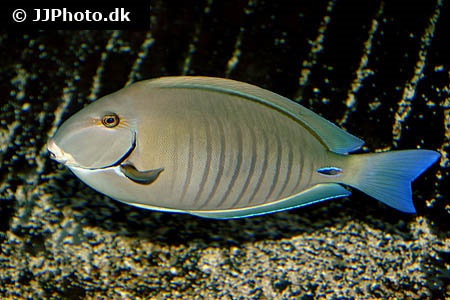Acanthurus chirurgus


| Latin name | Acanthurus chirurgus |
|---|---|
| Local name | Doctorfish |
| Family | Acanthuridae - Acanthurus |
| Origin | The Mexican Golf, West Atlantic |
| Max length | 39 cm (15.4") |
| Minimum volume |
2000 l (528 gal) |
|---|---|
| Hardiness |
Unknown |
| Suitable for aquarium |
Suitable with care |
| Reef safe |
Always reef safe |
| Aggressiveness | Might be aggressive |
| Recommended |
Macroalgea (Eg. seaweed / nori) Microalgea (Eg. spirulina) |
|---|---|
| Mostly |
Small crustaceans (Krill, mysis, artemia...) |
These fish should be kept in a well run aquarium where they can "graze" algae from rocks and stones.
If there are insufficient algae on the rocks, it is important to feed more frequently and supplement with algae rich food e.g. Spirulina.
This species revels in swimming and requires an aquarium with ample space.
This species requires places to hide, especially when newly introduced into the aquarium.
Even though these fish enjoy a diverse type of frozen foods, it is imperative that its primary food, is algae based, thus ensuring that the fish`s immune system remains healthy.
This can, for example, be plant based fish flakes, Nori seaweed or similar.
Some species in the Acanthurus genus mimic various Angelfish as juvenile, since predatory fish know that small Angelfish are hard to catch. They are therefore difficult to identify from a picture of adult fish.
Acanthurus species often place higher demands on: tank size, surroundings and water quality, than fish in the genus Zebrasoma.
Surgeonfish (Acanthuridae) live primarily of different types of algae, making it a popular choice for coral aquariums, as they help to keep the aquarium algae free.
Most Surgeonfish have a scalpel by the caudal fin, used to defend themselves. It can cause some deep lacerations, so pay attention if the fish start to fight and when handling the fish.
When in the aquarium, they will spend most of their time swimming around and nibbling the algae from the stones. Surgeonfish will rarely irritate corals or invertebrates. Large Palettes/Blue tangs can be an exception.
The Surgeonfish are not typically aggressive towards other types of fish. If more Surgeonfish are added to the aquarium, they will establish a hierarchy. It is best to add the most aggressive species last and to ensure that there are sufficient hiding places, as they prefer to have their own individual sleeping area.
If multiple aggressive species are added to the same aquarium, one runs the risk of one of them dying due to stress. One must therefore be cautious about adding multiple Acanthurus species or Zebrasoma xanthurum into the same aquarium. A combination of the different genera will normally get along well, although the more aggressive species can still be challenging.
Bob Fenner. The Tangs, Surgeons, Doctorfishes, of the Genus Acanthurus Part 1, Part 2 - Wet Web Media - (English)
Bob Fenner. The "Bad", Unknown and Just Too Dang Big Tangs, Surgeons, Doctorfishes, of the Genus Acanthurus - Wet Web Media - (English)
James W. Fatherree. 2009. Aquarium Fish: Surgeonfishes, A.K.A. the Tangs - Advanced Aquarist - (English)
Bob Fenner. Surgeons, Tangs and Doctorfishes, Family Acanthuridae - Wet Web Media - (English)
2013. Kirurgfisk - Saltvandswiki - (Danish)

